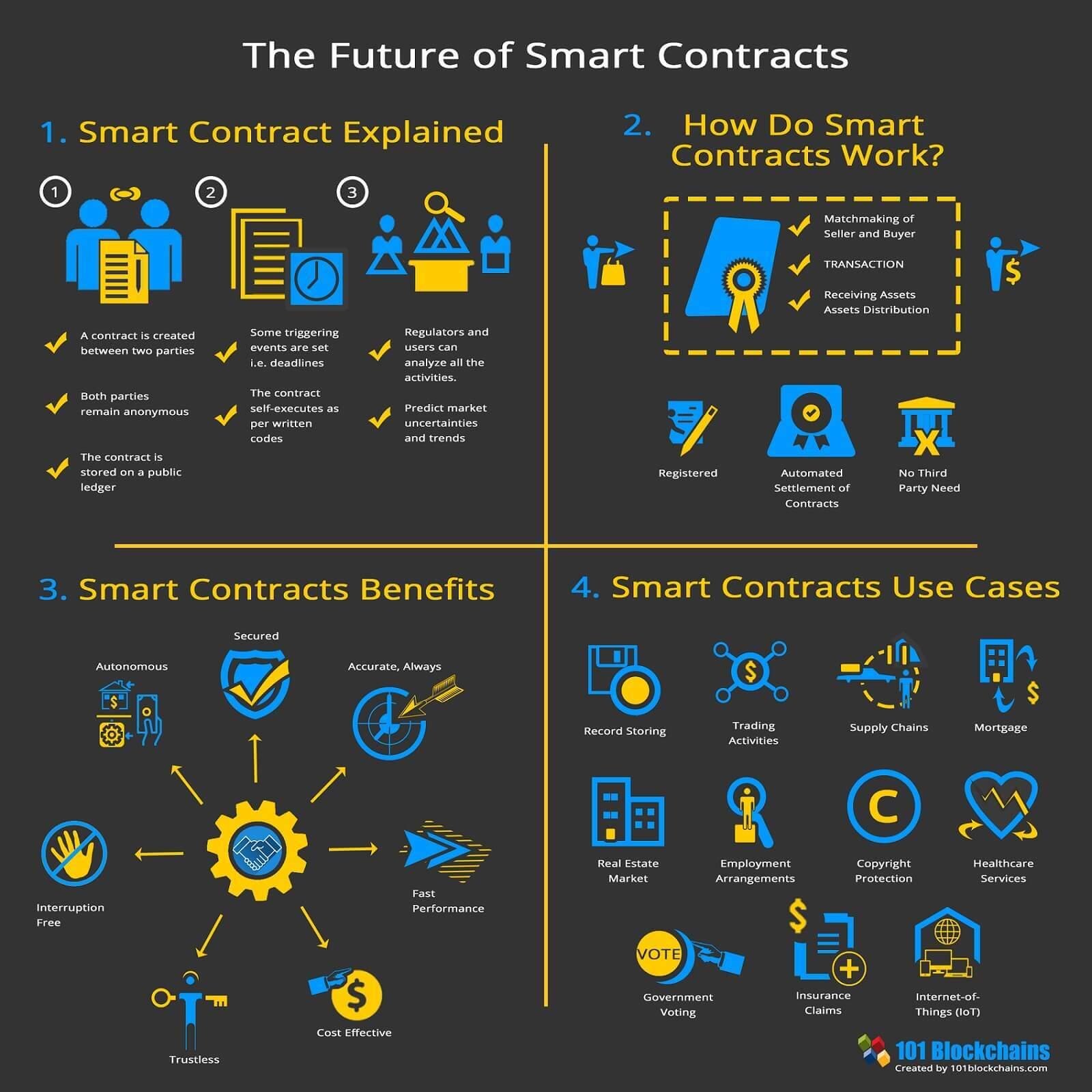Unlocking the Future: Understanding Ethereum Smart Contracts
As we stand on the brink of a digital renaissance, the term “smart contract” has begun to permeate conversations around technology, finance, and innovation. Amid this transformative landscape, Ethereum has emerged as a pioneering platform, revolutionizing the way we perceive and interact with agreements in the digital realm. Unlike traditional contracts, which are often bound by legalese and shrouded in bureaucracy, Ethereum smart contracts operate on a decentralized, transparent ledger, offering unprecedented autonomy and efficiency. But what exactly are these smart contracts, and how do they unlock the potential of blockchain technology? In this article, we will delve into the mechanics of Ethereum smart contracts, exploring their foundational principles, real-world applications, and the future they hold for a society that is increasingly reliant on digital solutions. Join us as we unveil the layers of this remarkable innovation and its promise to reshape our contractual landscape.
Exploring the Mechanics of Ethereum Smart Contracts
At the core of Ethereum’s revolutionary capabilities are smart contracts, self-executing agreements where the terms of the contract are directly written into code. Leveraging the Ethereum blockchain, these contracts automatically enforce and execute the provisions they contain, eliminating the need for intermediaries. The mechanics behind them rely on a robust network of nodes that validate transactions and maintain the distributed ledger, ensuring transparency and security. Each contract is written in Solidity, a language tailored for the Ethereum Virtual Machine (EVM), and can encapsulate complex logic, conditions, and functions that define its behavior. This innovative approach not only allows for trustless interactions but also opens the door to decentralized applications (dApps), remittances, and much more.
When diving into smart contracts, it’s crucial to understand their lifecycle, which consists of several key stages:
- Creation: A smart contract is deployed onto the Ethereum blockchain by a user, which initiates its existence.
- Execution: Upon receiving a transaction that meets its conditions, the contract executes programmed actions.
- Termination: The contract may self-terminate upon completion of its functions, which helps conserve network resources.
Moreover, it’s important to consider potential vulnerabilities and the need for regular audits to enhance security. Understanding the costs associated with deploying smart contracts is also essential, as users pay “gas” for computation, which can fluctuate based on network congestion.
| Aspect | Description |
|---|---|
| Language | Solidity |
| Execution | Decentralized and automatic |
| Cost | Gas fees based on complexity |

Navigating the Benefits and Challenges of Smart Contracts
Smart contracts, built on platforms like Ethereum, offer a revolutionary approach to automating agreements, powered by blockchain technology. The benefits they bring to the table are significant:
- Transparency: All participants can view the terms and conditions of the contract, reducing the likelihood of disputes.
- Security: Their decentralized nature ensures that once deployed, they are nearly impossible to alter or hack.
- Cost-effectiveness: By eliminating intermediaries, smart contracts can reduce costs associated with traditional legal processes.
- Speed: Automated execution allows for immediate processing of contracts, saving time and streamlining operations.
However, these advantages come with their own set of challenges that require careful consideration. One major concern is:
- Complexity: Designing effective smart contracts demands substantial technical knowledge, which can be a barrier for small businesses.
- Regulation: The legal status of smart contracts can vary significantly across jurisdictions, leading to uncertainty.
- Immutability: While security is a plus, it also means that errors in the coding of a contract can have permanent consequences, potentially leading to loss of funds.
- Limited understanding: Many users lack awareness of how smart contracts operate, which can hinder their widespread adoption.

Best Practices for Developing Secure Smart Contracts
Ensuring the security of smart contracts is paramount, given the irreversible nature of blockchain transactions. To mitigate potential vulnerabilities, developers should adhere to a set of established best practices. Code audits should be conducted regularly, either through peer reviews or professional services, to identify and rectify bugs before deployment. Additionally, employing modular designs can allow for easier updates and fortify security by limiting the complexity of the contract. Further, integrating automated testing frameworks can safeguard the logic of contracts, ensuring that various scenarios are thoroughly evaluated.
Another crucial aspect of smart contract development involves adhering to established standards and practices. Developers should consider implementing Time Lock mechanisms to prevent unauthorized access during the initial period following deployment. On top of that, utilizing security libraries like OpenZeppelin can provide tested, community-vetted code, which decreases the incidence of defects. It’s also wise to engage in a bug bounty program, inviting white-hat hackers to test your contract and report vulnerabilities. Employing these strategies not only promotes security but also builds trust within the community, showcasing a commitment to responsible development.

Future Trends in Ethereum Smart Contracts and Their Impact
As Ethereum continues to evolve, the future landscape of smart contracts is poised for transformative changes. Innovations like layer-2 solutions, cross-chain interoperability, and upgradable contracts are set to redefine how developers and businesses interact with blockchain technology. These advancements promise to enhance scalability, reduce transaction costs, and eliminate bottlenecks currently facing the Ethereum network. Key trends shaping this evolution include:
- Enhanced Security Protocols: Introduction of more sophisticated security measures to protect contracts from vulnerabilities.
- Integration with AI: Leveraging artificial intelligence to automate and optimize contract execution.
- Audit and Compliance Mechanisms: Development of integrated tools for real-time auditing to ensure compliance with regulations.
Moreover, as industries adopt decentralized finance (DeFi) protocols and non-fungible tokens (NFTs), the demand for flexible, modular smart contracts will surge. In response, developers will likely focus on creating standardized frameworks that streamline the deployment process across various sectors. This will pave the way for more complex use cases, such as:
| Use Case | Description |
|---|---|
| Decentralized Identity | Smart contracts managing user identities and access across platforms. |
| Supply Chain Transparency | Automating verification of product provenance from creation to end-user. |
| Insurance Automation | Real-time claim processing based on oracle-driven data inputs. |
Concluding Remarks
As we stand on the precipice of a digital revolution, the promise of Ethereum smart contracts beckons an era of transparency, efficiency, and innovation. Much like a key unlocking a door to infinite possibilities, these self-executing agreements are redefining the landscape of transactions and decentralized applications.
In this exploration of Ethereum’s potential, we have traversed the foundational principles of blockchain technology, dissected the mechanics of smart contracts, and glimpsed the transformative impact they can have across industries. Yet, as with any profound change, challenges remain, and navigating these complexities will require collaborative efforts from developers, regulators, and users alike.
The future is undeniably intertwined with the pathways forged by Ethereum and its smart contracts. As we continue to unlock their capabilities, fostering a deeper understanding and encouraging responsible adoption will be paramount. This journey has only just begun, but one thing is clear: the potential is as limitless as the imagination that drives it. Join us as we step into this brave new world, where contracts are not merely ink on paper, but living entities capable of reshaping our economic and social fabric. The key is in our hands—let’s turn it wisely.






